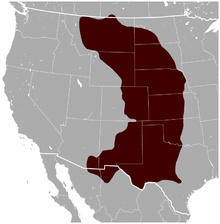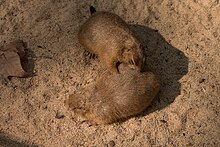Black-tailed prairie dog
| Black-tailed prairie dog | ||||||||||||
|---|---|---|---|---|---|---|---|---|---|---|---|---|

Black-tailed prairie dog |
||||||||||||
| Systematics | ||||||||||||
|
||||||||||||
| Scientific name | ||||||||||||
| Cynomys ludovicianus | ||||||||||||
| ( Ord , 1815) |
The black-tailed prairie dog ( Cynomys ludovicianus ) is a species of prairie dogs from the subfamily of ground squirrels that lives in North America and belongs to the rodent order . It owes the name "prairie dog" to its habitat, the prairie , and its warning calls, which reminded the early settlers of the barking of domestic dogs.
features
Adult black-tailed prairie dogs over a year old have a head-to-trunk length of 28–33 cm and a tail length of 7–11.5 cm. The total length is 35.5–41.5 cm, erect they reach a height of about 30 cm. The weight of 253-1390 grams varies with the season, the males are usually 5% -15% heavier than the females.
Apart from rare albinos , the top of the black-tailed prairie dogs is brown or reddish brown, the underside whitish. Sometimes digging makes the fur color resemble the color of the soil. The fur is twice a year changed , the change will take about two weeks. Most hair is black at the base in winter, then pale tawny brown, with a subterminal cinnamon band and white tip. In summer, most of the hair is black at the base, then whitish, then cinnamon, followed by a subterminal yellow-brown band and narrow black tip. The summer hair is mixed with numerous, rather longer, completely black or half black hair. The whiskers and the last third of the tail are black.
Black-tailed prairie dogs have five fingers with black, slightly curved claws. The angular head is broad with large eyes, the iris is dark brown.
distribution and habitat
Black-tailed prairie dogs are primarily a species of the Great Plains . Originally, they came from the Frenchman River Valley in the extreme south of the Saskatchewan Province in Canada and from Montana in the USA south through the western and central Great Plains to the desert grasslands of Texas , New Mexico and southeastern Arizona in the USA to the northeast Sonora and Northern Chihuahua in Mexico. The species is now extinct in southeastern Arizona, southwestern New Mexico, and locally in many other areas of the original range. Black-tailed prairie dogs occur in isolated colonies within the original range, many of them in national parks , state parks, and the National Wildlife Refuge .
Black-tailed prairie dogs inhabit dry, flat or gently sloping, open grasslands with low, relatively sparse vegetation, including areas overlaid by cattle. In some areas the species is also found in vacant lots on the outskirts of cities. Their habitat includes long grass, mixed grass and short grass prairie all types of grassland.
Way of life
Blacktail prairie dogs are diurnal and like the Mexican prairie dogs , unlike other species, do not hibernate . In extremely cold weather, however, they sometimes stay underground for several consecutive days. Prairie dogs live in carefully crafted burrows. The tunnels are typically 10 to 30 cm in diameter and are usually 5 to 10 m long and one to two meters deep. There are several elliptical chambers padded with dry grass, with the black-tailed prairie dogs each chamber is approximately 30 cm high and 50 cm wide.
Black-tailed prairie dogs are sexually mature at around two years of age , and the first copulation usually occurs in February or March after birth. After a gestation period of 33-38 days, up to eight young are born.
Social structure
Prairie dogs are social, ferocious animals that live in colonies, also called cities. The largest colony is said to have been around 1900 at Vernon Bailey, Texas, and counted approximately 400 million individuals over an area of 100 by 250 miles . Today's largest colony with around 15,000 hectares is located near Janos, Mexico. Most of the existing colonies are fragmented by agriculture and urban development, with population densities varying from 5 to 35 animals per acre . The family units, called cliques ( coteries ), consist of one male, up to five females and their young.
food
Blacktail prairie dog diets vary according to the season. In summer they feed on sweet grasses such as crested curls ( Agropyron ), Bouteloua species and buffalo grass ( Buchloe dactyloides ), from Chrysothamnus species and Sphaeralcea coccinea . In winter they eat Opuntia species, thistles and underground roots. There are also cases of cannibalism in the species . Black-tailed prairie dogs kill and eat conspecific young animals. Conspecifics that perish underground are also eaten.
The water content of the food is sufficient for the daily water requirement, but metabolic water also contributes to the coverage of the requirement.
Systematics
Before 1975, two subspecies were recognized according to Hollister (1916):
- Cynomys ludovicianus ludovicianus
- Cynomys ludovicianus arizonensis Mearns 1890
Based on morphometric analyzes, Pizzimenti (1975) concluded that there is no reason to endorse subspecies. Hoffmeister (1986) followed the recommendation, so that Cynomys ludovicianus is considered monotypical .
Danger
Due to the very large distribution area, the estimated several million individuals and because the population is not declining so quickly that a classification in a higher category would be justified, the Blacktail Prairie Dog is approved by the International Union for Conservation of Nature and Natural Resources (IUCN) classified as Least Concern (LC).
literature
- David Burnei (Ed.): Animals. (The large picture encyclopedia with over 2000 species). Dorling Kindersley, Munich 2001, ISBN 3-8310-0202-9 .
Individual evidence
- ^ IUCN (International Union for Conservation of Nature) 2008. Cynomys ludovicianus . In: IUCN 2014. The IUCN Red List of Threatened Species. Version 2014.3, on iucnredlist.org. Downloaded January 29, 2015.
- ↑ a b c d e f g h i George A. Feldhamer, Bruce Carlyle Thompson, Joseph A. Chapma (eds.): Wild Mammals of North America. Biology, Management, and Conservation. 2nd Edition. Johns Hopkins University Press, Baltimore MD et al. 2003, ISBN 0-8018-7416-5 , p. 232.
- ↑ a b c d e John L. Hoogland: Cynomys ludovicianus. In: Mammalian Species . No. 535, 1996, pp. 1-10, online , (PDF; 1.1 MB).
- ↑ a b c Holly L. May: Black-tailed Prairie Dog (Cynomys ludovicianus) (= Fish and Wildlife Habitat Management Leaflet. No. 23, July 2001). Wildlife Habitat Management Institute, Madison MS 2001, Online ( Memento of the original from October 29, 2013 in the Internet Archive ) Info: The archive link was inserted automatically and has not yet been checked. Please check the original and archive link according to the instructions and then remove this notice. (PDF; 486 kB), accessed on January 14, 2012.
- ↑ a b c d Cynomys ludovicianus in the IUCN Red List of Threatened Species 2011.1. Posted by: AV Linzey & NatureServe, 2008. Retrieved August 13, 2011.
- ↑ Jason Northcott, Mark C. Andersen, Gary W. Roemer, Ed L. Fredrickson, Michael DeMers, Joe Truett, Paulette L. Ford: Spatial Analysis of Effects of Mowing and Burning on Colony Expansion in Reintroduced Black-Tailed Prairie Dog (Cynomys ludovicianus). In: Restoration Ecology. Vol. 16, No. 3, 2008, ISSN 1061-2971 , pp. 495–502, doi : 10.1111 / j.1526-100X.2007.00323.x , online ( page no longer available , search in web archives ) Info: The link was automatically marked as defective. Please check the link according to the instructions and then remove this notice. , accessed January 14, 2012.
- ↑ David J. Hafner, Eric Yensen, Gordon L. Kirkland Jr. (Eds.): North American Rodents. Status Survey and Conservation Action Plan. IUCN, Gland et al. 1998, ISBN 2-8317-0463-4 , p. 35.
Web links
- Nancy Shefferly: Cynomys ludovicianus. In: Animal Diversity Web, 1999.


